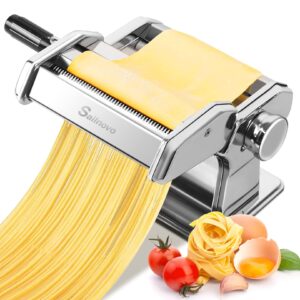 As a pasta lover, a pasta maker is an indispensable tool in your kitchen that allows you to create healthier and more delectable homemade pasta dishes than those available in stores, yet to guarantee its longevity and the production of delicious pasta, regular cleaning and maintenance are essential.
As a pasta lover, a pasta maker is an indispensable tool in your kitchen that allows you to create healthier and more delectable homemade pasta dishes than those available in stores, yet to guarantee its longevity and the production of delicious pasta, regular cleaning and maintenance are essential.
Cleaning Your Pasta Maker
Cleaning your pasta maker is an essential part of maintenance. Over time, residue from the ingredients used to make pasta can build up on the machine and affect its performance. Before you start cleaning your pasta maker, make sure that you have unplugged it from the electrical source.
Here are some steps to follow when cleaning your pasta maker:
Disassemble the machine: Begin by disassembling the pasta maker. Remove all of the attachments and accessories, including the rollers and cutters.
Clean the rollers: Use a brush or toothpick to remove any debris or flour that may be stuck in the crevices of the rollers. You can also use a damp cloth to clean the rollers if necessary.
Wash the removable parts: Wash the removable parts of the pasta maker with warm, soapy water. Use a sponge or soft brush to remove any debris and rinse thoroughly with clean water. Avoid immersing the machine in water or putting it in the dishwasher.
Wipe down the non-removable parts: Use a damp cloth to wipe down the non-removable parts of the pasta maker, including the motor and base. Make sure to dry all of the parts thoroughly before reassembling the machine.
Maintaining Your Pasta Maker
In addition to regular cleaning, there are several steps you can take to maintain your pasta maker and ensure that it lasts for years to come. Here are some tips for maintaining your pasta maker:
- Use high-quality ingredients: When making pasta, make sure to use high-quality ingredients, including flour, eggs, and water. Avoid using hard or stale flour, as this can damage the rollers.
- Don’t overload the machine: Avoid overloading the machine with too much dough when making pasta. This can put a strain on the motor and cause it to wear out more quickly.
- Lubricate the moving parts: Over time, the moving parts of your pasta maker may become stiff or difficult to turn. To keep the machine running smoothly, you can apply a small amount of vegetable oil or WD-40 to the moving parts to lubricate them.
- Store the machine properly: When not in use, store your pasta maker in a cool, dry place. Make sure to cover the machine with a clean cloth or plastic wrap to protect it from dust and debris.
- Replace worn parts: If you notice that any parts of your machine are worn or damaged, such as the cutters or rollers, be sure to replace them as soon as possible. Using a pasta maker with worn or damaged parts can cause the machine to malfunction and may even be dangerous.
Additional Tips for Cleaning and Maintaining Your Pasta Maker
When working with your machine, avoid using metal utensils that can scratch the rollers or damage the machine. Before using the machine, use a dry brush to remove any debris or flour that may be on the machine. While it’s essential to clean your machine regularly, avoid washing it too frequently. Excessive washing can damage the machine and cause it to wear out more quickly. When cleaning and maintaining your machine, make sure to follow the manufacturer’s instructions. Different models may have different cleaning and maintenance requirements.
By properly cleaning and maintaining your pasta maker, a valuable tool in any kitchen, you can ensure that it continues to produce delicious homemade pasta for years to come, and regular cleaning and maintenance are essential for keeping your machine in good condition and ensuring its longevity, making it a reliable and enjoyable kitchen tool that provides you and your family with tasty homemade pasta.